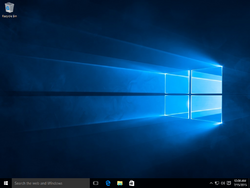This page is currently a draft. Don't link drafts to main pages.
Draft:Explorer
| Component of Microsoft Windows | |
 Explorer in Windows 10 (original release) | |
| Type | Desktop shell |
|---|---|
| Introduced in | Windows 95 Usability Testing Builds |
Windows Explorer (explorer.exe) is the default GUI in Microsoft Windows. Explorer is responsible for the desktop, taskbar and start menu. It was introduced in the Windows 95 Usability Testing Builds, replacing the old Program Manager used in Windows 3.x.
History[edit source]
Windows 95[edit source]
Microsoft first tested a shell refresh during the development of Windows 95. Dubbed the Shell Technology Preview, this was a brand new interface designed to replace the old Program Manager, used in Windows 3.x. Shell Technology Preview.
Windows Desktop Update[edit source]
In Windows 98, the Quick Launch utility was added. This makes it convenient for users to launch programs straightly from the taskbar instead of looking for it in the Start menu. It was ported to the Windows NT line with Windows 2000. It can also be installed onto Windows 95 and Windows NT 4.0 with the Windows Desktop Update included in Internet Explorer 4.
Windows XP[edit source]
With the release of Windows XP, Visual styles were added, which redesigned Windows Explorer and the shell as a whole.
Windows Vista[edit source]
During the development of Windows Vista, a search panel was added to the start menu. It was also updated to have Aero effects.
Windows 7[edit source]
In Windows 7, the Quick Launch feature was removed (albeit you could still re-enable it with a toolbar) and replaced with a program pinning system. Windows 7 also made the taskbar larger with the introduction of the Superbar in build 6469.
Windows 8/8.1[edit source]
During the development of Windows 8, the start menu was scrapped entirely and replaced with a Start screen. This was widely criticized due to the interface mainly being designed for use on tablets and difficult to use with the mouse. Windows 8.1 allowed the user to skip the Start screen after startup and to directly boot into the desktop. Some features missing with the Start screen were readded with Windows 8.1 Update 1, such as Search and Power buttons and context menus. A planned Start menu in style of the Start screen shipped with Update 3 for ARM32 devices, with the x86 and x64 implementations instead appearing in pre-release builds of Windows 10.
Windows 10[edit source]
During the development of Windows 10, a search and task view button was added to the taskbar. The start menu was added back in build 9780. The Start menu appearance then changed in Windows 10 Anniversary Update, with the Explorer, All Apps, Settings and Power buttons moving to a separate menu at the left edge of the menu. It can be expanded by clicking or tapping on the menu button at the top. Since Windows 10 November 2019 Update, it automatically expands if the mouse cursor is hovered over the menu. A full screen appearance of the Start menu can be activated over the Settings.
Windows 11[edit source]
In Windows 11 build 21996, a centered taskbar and brand new start menu was added. A search box in the menu was not added until build 22000.65. In the 22H2 update, Application Folders were added, as well as the ability to choose the start menu layout.
[edit source]
Classic Windows[edit source]
The desktop and taskbar in Windows 95 build 58s
The desktop and taskbar in Windows 95 build 189
The desktop and taskbar in the RTM release of Windows 95
The start menu in Windows 98 build 1351
The desktop in Windows 98 build 1532, notice the Quick Launch
Windows XP-7[edit source]
The desktop and taskbar in Windows XP build 2287
The desktop and taskbar in Windows XP build 2454
The desktop and taskbar in the RTM release of Windows XP
The start menu in Windows Vista build 5337, notice the Search bar
The classic start menu in the RTM release of Windows Vista
The superbar in Windows 7 build 6469 (with Aero on)
The desktop and taskbar in the RTM release of Windows 7
Windows 8-11[edit source]
Early start screen in Windows 8 build 7814
Start screen in Windows 8 build 7899
Start screen in Windows 8 build 8032
Start screen in Windows 8 build 8102.101
Start screen in the RTM release of Windows 8
Start screen in the RTM release of Windows 8.1
Start menu in Windows 10 build 9841 (fbl_release)
Start menu in Windows 10 build 10056 (fbl_impressive)
Start menu in the RTM release of Windows 10
Start menu in Windows 10 build 18946
Start menu in Windows 10 build 20161
Start menu in Windows 10X build 20279.1002
Start menu in Windows 11 build 21996
Start menu in the RTM release of Windows 11


























